COVID-19's Impact on Supply Chain & Operations Management
VerifiedAdded on 2023/02/01
|5
|2022
|36
Report
AI Summary
This research paper investigates the profound impact of the COVID-19 pandemic on sustainable production and operations management within global supply chains. It highlights the critical importance of effective supply chain management for overall profitability and competitive advantage, emphasizing the disruptions caused by the pandemic. The paper draws parallels to wartime production, stressing the significance of communication, flexibility, and transparency in crisis response. It defines supply chain resilience, outlining the factors of preparation, response, recovery, and growth. The research recommends performing a SWOT analysis to identify vulnerabilities and risks, as well as regularly stress-testing supply chains to assess capacity, inventory, and demand. The paper concludes by emphasizing the need for organizational leaders to adapt and innovate, leveraging global capabilities while enhancing resilience against future disruptions.
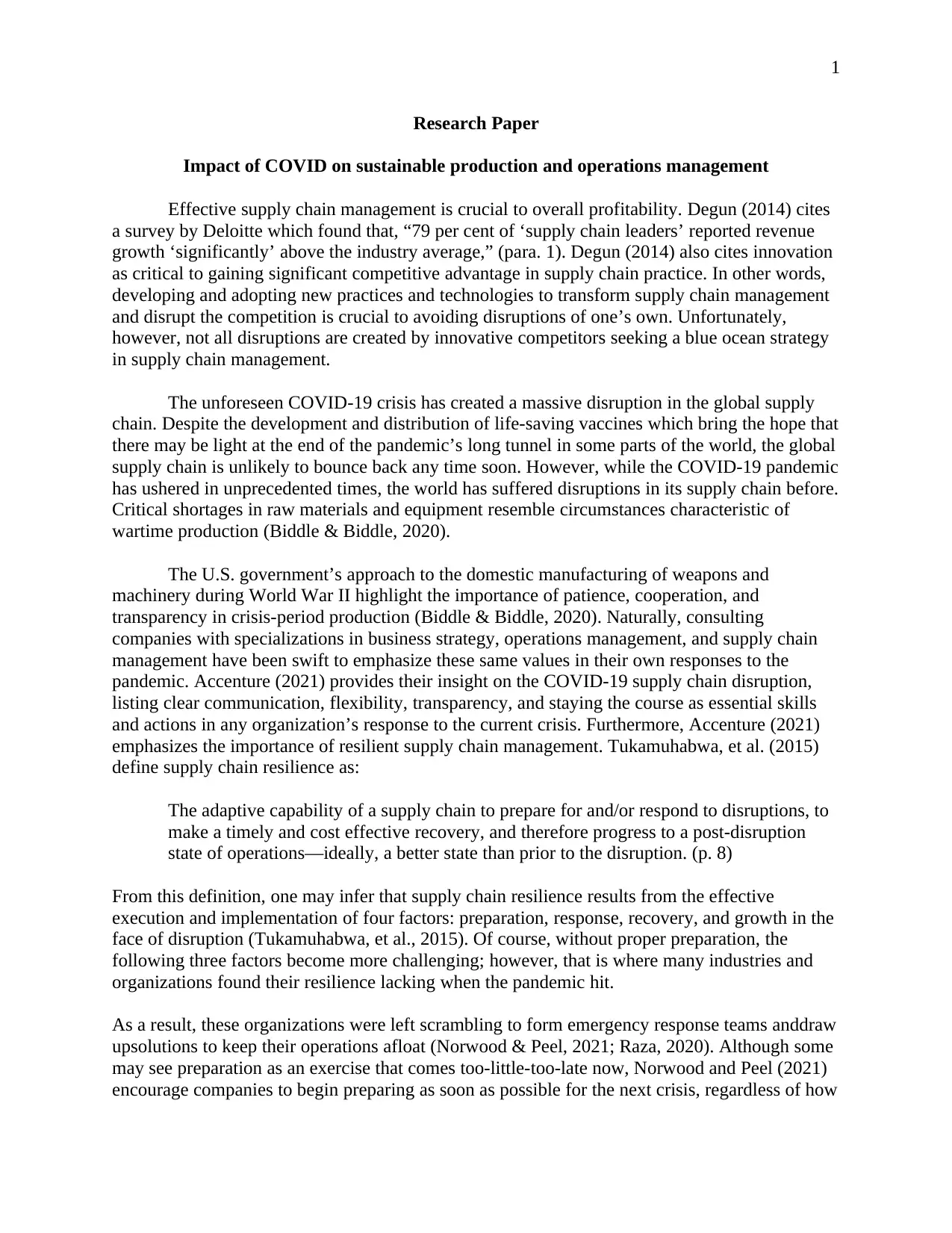
1
Research Paper
Impact of COVID on sustainable production and operations management
Effective supply chain management is crucial to overall profitability. Degun (2014) cites
a survey by Deloitte which found that, “79 per cent of ‘supply chain leaders’ reported revenue
growth ‘significantly’ above the industry average,” (para. 1). Degun (2014) also cites innovation
as critical to gaining significant competitive advantage in supply chain practice. In other words,
developing and adopting new practices and technologies to transform supply chain management
and disrupt the competition is crucial to avoiding disruptions of one’s own. Unfortunately,
however, not all disruptions are created by innovative competitors seeking a blue ocean strategy
in supply chain management.
The unforeseen COVID-19 crisis has created a massive disruption in the global supply
chain. Despite the development and distribution of life-saving vaccines which bring the hope that
there may be light at the end of the pandemic’s long tunnel in some parts of the world, the global
supply chain is unlikely to bounce back any time soon. However, while the COVID-19 pandemic
has ushered in unprecedented times, the world has suffered disruptions in its supply chain before.
Critical shortages in raw materials and equipment resemble circumstances characteristic of
wartime production (Biddle & Biddle, 2020).
The U.S. government’s approach to the domestic manufacturing of weapons and
machinery during World War II highlight the importance of patience, cooperation, and
transparency in crisis-period production (Biddle & Biddle, 2020). Naturally, consulting
companies with specializations in business strategy, operations management, and supply chain
management have been swift to emphasize these same values in their own responses to the
pandemic. Accenture (2021) provides their insight on the COVID-19 supply chain disruption,
listing clear communication, flexibility, transparency, and staying the course as essential skills
and actions in any organization’s response to the current crisis. Furthermore, Accenture (2021)
emphasizes the importance of resilient supply chain management. Tukamuhabwa, et al. (2015)
define supply chain resilience as:
The adaptive capability of a supply chain to prepare for and/or respond to disruptions, to
make a timely and cost effective recovery, and therefore progress to a post-disruption
state of operations—ideally, a better state than prior to the disruption. (p. 8)
From this definition, one may infer that supply chain resilience results from the effective
execution and implementation of four factors: preparation, response, recovery, and growth in the
face of disruption (Tukamuhabwa, et al., 2015). Of course, without proper preparation, the
following three factors become more challenging; however, that is where many industries and
organizations found their resilience lacking when the pandemic hit.
As a result, these organizations were left scrambling to form emergency response teams anddraw
upsolutions to keep their operations afloat (Norwood & Peel, 2021; Raza, 2020). Although some
may see preparation as an exercise that comes too-little-too-late now, Norwood and Peel (2021)
encourage companies to begin preparing as soon as possible for the next crisis, regardless of how
Research Paper
Impact of COVID on sustainable production and operations management
Effective supply chain management is crucial to overall profitability. Degun (2014) cites
a survey by Deloitte which found that, “79 per cent of ‘supply chain leaders’ reported revenue
growth ‘significantly’ above the industry average,” (para. 1). Degun (2014) also cites innovation
as critical to gaining significant competitive advantage in supply chain practice. In other words,
developing and adopting new practices and technologies to transform supply chain management
and disrupt the competition is crucial to avoiding disruptions of one’s own. Unfortunately,
however, not all disruptions are created by innovative competitors seeking a blue ocean strategy
in supply chain management.
The unforeseen COVID-19 crisis has created a massive disruption in the global supply
chain. Despite the development and distribution of life-saving vaccines which bring the hope that
there may be light at the end of the pandemic’s long tunnel in some parts of the world, the global
supply chain is unlikely to bounce back any time soon. However, while the COVID-19 pandemic
has ushered in unprecedented times, the world has suffered disruptions in its supply chain before.
Critical shortages in raw materials and equipment resemble circumstances characteristic of
wartime production (Biddle & Biddle, 2020).
The U.S. government’s approach to the domestic manufacturing of weapons and
machinery during World War II highlight the importance of patience, cooperation, and
transparency in crisis-period production (Biddle & Biddle, 2020). Naturally, consulting
companies with specializations in business strategy, operations management, and supply chain
management have been swift to emphasize these same values in their own responses to the
pandemic. Accenture (2021) provides their insight on the COVID-19 supply chain disruption,
listing clear communication, flexibility, transparency, and staying the course as essential skills
and actions in any organization’s response to the current crisis. Furthermore, Accenture (2021)
emphasizes the importance of resilient supply chain management. Tukamuhabwa, et al. (2015)
define supply chain resilience as:
The adaptive capability of a supply chain to prepare for and/or respond to disruptions, to
make a timely and cost effective recovery, and therefore progress to a post-disruption
state of operations—ideally, a better state than prior to the disruption. (p. 8)
From this definition, one may infer that supply chain resilience results from the effective
execution and implementation of four factors: preparation, response, recovery, and growth in the
face of disruption (Tukamuhabwa, et al., 2015). Of course, without proper preparation, the
following three factors become more challenging; however, that is where many industries and
organizations found their resilience lacking when the pandemic hit.
As a result, these organizations were left scrambling to form emergency response teams anddraw
upsolutions to keep their operations afloat (Norwood & Peel, 2021; Raza, 2020). Although some
may see preparation as an exercise that comes too-little-too-late now, Norwood and Peel (2021)
encourage companies to begin preparing as soon as possible for the next crisis, regardless of how
Paraphrase This Document
Need a fresh take? Get an instant paraphrase of this document with our AI Paraphraser
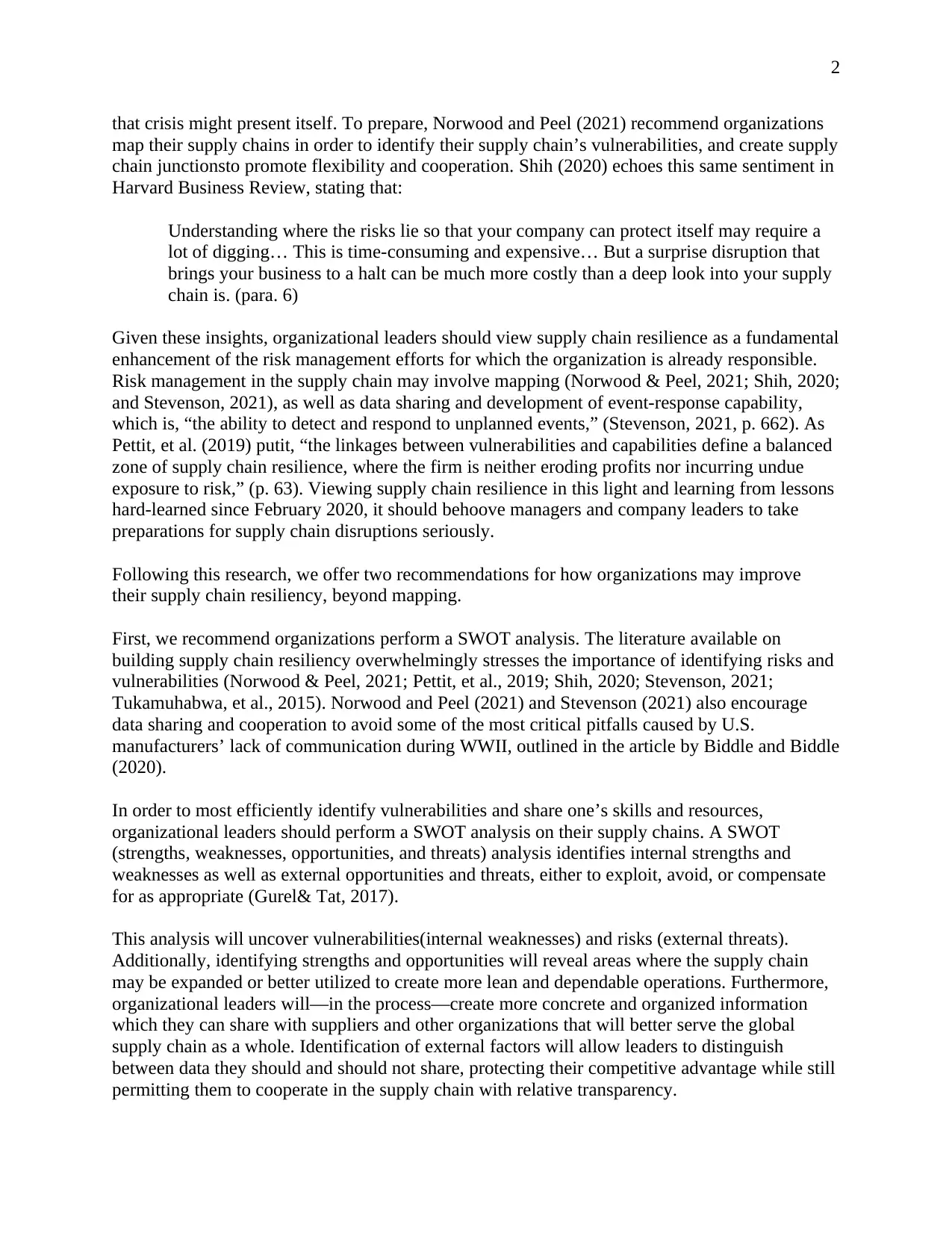
2
that crisis might present itself. To prepare, Norwood and Peel (2021) recommend organizations
map their supply chains in order to identify their supply chain’s vulnerabilities, and create supply
chain junctionsto promote flexibility and cooperation. Shih (2020) echoes this same sentiment in
Harvard Business Review, stating that:
Understanding where the risks lie so that your company can protect itself may require a
lot of digging… This is time-consuming and expensive… But a surprise disruption that
brings your business to a halt can be much more costly than a deep look into your supply
chain is. (para. 6)
Given these insights, organizational leaders should view supply chain resilience as a fundamental
enhancement of the risk management efforts for which the organization is already responsible.
Risk management in the supply chain may involve mapping (Norwood & Peel, 2021; Shih, 2020;
and Stevenson, 2021), as well as data sharing and development of event-response capability,
which is, “the ability to detect and respond to unplanned events,” (Stevenson, 2021, p. 662). As
Pettit, et al. (2019) putit, “the linkages between vulnerabilities and capabilities define a balanced
zone of supply chain resilience, where the firm is neither eroding profits nor incurring undue
exposure to risk,” (p. 63). Viewing supply chain resilience in this light and learning from lessons
hard-learned since February 2020, it should behoove managers and company leaders to take
preparations for supply chain disruptions seriously.
Following this research, we offer two recommendations for how organizations may improve
their supply chain resiliency, beyond mapping.
First, we recommend organizations perform a SWOT analysis. The literature available on
building supply chain resiliency overwhelmingly stresses the importance of identifying risks and
vulnerabilities (Norwood & Peel, 2021; Pettit, et al., 2019; Shih, 2020; Stevenson, 2021;
Tukamuhabwa, et al., 2015). Norwood and Peel (2021) and Stevenson (2021) also encourage
data sharing and cooperation to avoid some of the most critical pitfalls caused by U.S.
manufacturers’ lack of communication during WWII, outlined in the article by Biddle and Biddle
(2020).
In order to most efficiently identify vulnerabilities and share one’s skills and resources,
organizational leaders should perform a SWOT analysis on their supply chains. A SWOT
(strengths, weaknesses, opportunities, and threats) analysis identifies internal strengths and
weaknesses as well as external opportunities and threats, either to exploit, avoid, or compensate
for as appropriate (Gurel& Tat, 2017).
This analysis will uncover vulnerabilities(internal weaknesses) and risks (external threats).
Additionally, identifying strengths and opportunities will reveal areas where the supply chain
may be expanded or better utilized to create more lean and dependable operations. Furthermore,
organizational leaders will—in the process—create more concrete and organized information
which they can share with suppliers and other organizations that will better serve the global
supply chain as a whole. Identification of external factors will allow leaders to distinguish
between data they should and should not share, protecting their competitive advantage while still
permitting them to cooperate in the supply chain with relative transparency.
that crisis might present itself. To prepare, Norwood and Peel (2021) recommend organizations
map their supply chains in order to identify their supply chain’s vulnerabilities, and create supply
chain junctionsto promote flexibility and cooperation. Shih (2020) echoes this same sentiment in
Harvard Business Review, stating that:
Understanding where the risks lie so that your company can protect itself may require a
lot of digging… This is time-consuming and expensive… But a surprise disruption that
brings your business to a halt can be much more costly than a deep look into your supply
chain is. (para. 6)
Given these insights, organizational leaders should view supply chain resilience as a fundamental
enhancement of the risk management efforts for which the organization is already responsible.
Risk management in the supply chain may involve mapping (Norwood & Peel, 2021; Shih, 2020;
and Stevenson, 2021), as well as data sharing and development of event-response capability,
which is, “the ability to detect and respond to unplanned events,” (Stevenson, 2021, p. 662). As
Pettit, et al. (2019) putit, “the linkages between vulnerabilities and capabilities define a balanced
zone of supply chain resilience, where the firm is neither eroding profits nor incurring undue
exposure to risk,” (p. 63). Viewing supply chain resilience in this light and learning from lessons
hard-learned since February 2020, it should behoove managers and company leaders to take
preparations for supply chain disruptions seriously.
Following this research, we offer two recommendations for how organizations may improve
their supply chain resiliency, beyond mapping.
First, we recommend organizations perform a SWOT analysis. The literature available on
building supply chain resiliency overwhelmingly stresses the importance of identifying risks and
vulnerabilities (Norwood & Peel, 2021; Pettit, et al., 2019; Shih, 2020; Stevenson, 2021;
Tukamuhabwa, et al., 2015). Norwood and Peel (2021) and Stevenson (2021) also encourage
data sharing and cooperation to avoid some of the most critical pitfalls caused by U.S.
manufacturers’ lack of communication during WWII, outlined in the article by Biddle and Biddle
(2020).
In order to most efficiently identify vulnerabilities and share one’s skills and resources,
organizational leaders should perform a SWOT analysis on their supply chains. A SWOT
(strengths, weaknesses, opportunities, and threats) analysis identifies internal strengths and
weaknesses as well as external opportunities and threats, either to exploit, avoid, or compensate
for as appropriate (Gurel& Tat, 2017).
This analysis will uncover vulnerabilities(internal weaknesses) and risks (external threats).
Additionally, identifying strengths and opportunities will reveal areas where the supply chain
may be expanded or better utilized to create more lean and dependable operations. Furthermore,
organizational leaders will—in the process—create more concrete and organized information
which they can share with suppliers and other organizations that will better serve the global
supply chain as a whole. Identification of external factors will allow leaders to distinguish
between data they should and should not share, protecting their competitive advantage while still
permitting them to cooperate in the supply chain with relative transparency.
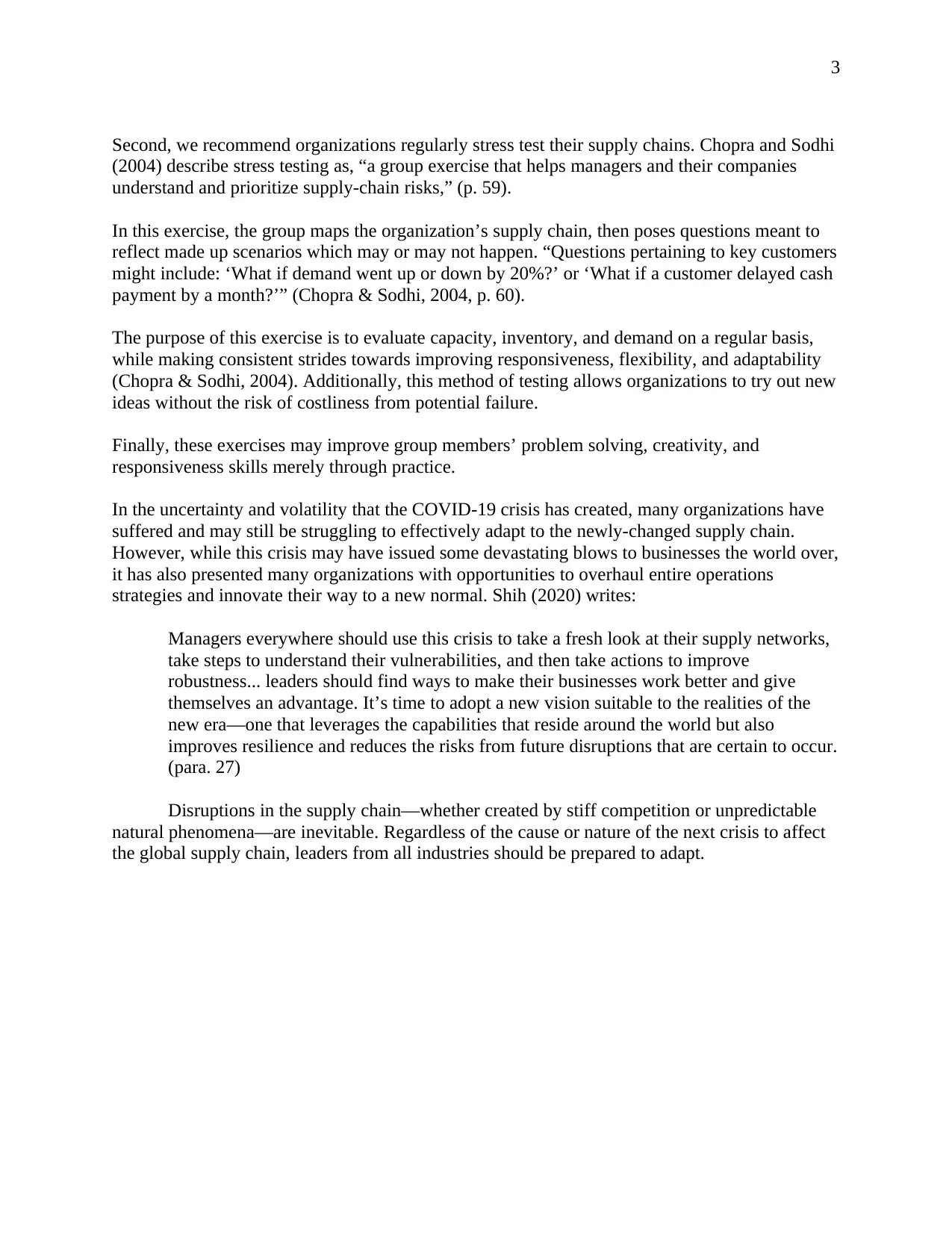
3
Second, we recommend organizations regularly stress test their supply chains. Chopra and Sodhi
(2004) describe stress testing as, “a group exercise that helps managers and their companies
understand and prioritize supply-chain risks,” (p. 59).
In this exercise, the group maps the organization’s supply chain, then poses questions meant to
reflect made up scenarios which may or may not happen. “Questions pertaining to key customers
might include: ‘What if demand went up or down by 20%?’ or ‘What if a customer delayed cash
payment by a month?’” (Chopra & Sodhi, 2004, p. 60).
The purpose of this exercise is to evaluate capacity, inventory, and demand on a regular basis,
while making consistent strides towards improving responsiveness, flexibility, and adaptability
(Chopra & Sodhi, 2004). Additionally, this method of testing allows organizations to try out new
ideas without the risk of costliness from potential failure.
Finally, these exercises may improve group members’ problem solving, creativity, and
responsiveness skills merely through practice.
In the uncertainty and volatility that the COVID-19 crisis has created, many organizations have
suffered and may still be struggling to effectively adapt to the newly-changed supply chain.
However, while this crisis may have issued some devastating blows to businesses the world over,
it has also presented many organizations with opportunities to overhaul entire operations
strategies and innovate their way to a new normal. Shih (2020) writes:
Managers everywhere should use this crisis to take a fresh look at their supply networks,
take steps to understand their vulnerabilities, and then take actions to improve
robustness... leaders should find ways to make their businesses work better and give
themselves an advantage. It’s time to adopt a new vision suitable to the realities of the
new era—one that leverages the capabilities that reside around the world but also
improves resilience and reduces the risks from future disruptions that are certain to occur.
(para. 27)
Disruptions in the supply chain—whether created by stiff competition or unpredictable
natural phenomena—are inevitable. Regardless of the cause or nature of the next crisis to affect
the global supply chain, leaders from all industries should be prepared to adapt.
Second, we recommend organizations regularly stress test their supply chains. Chopra and Sodhi
(2004) describe stress testing as, “a group exercise that helps managers and their companies
understand and prioritize supply-chain risks,” (p. 59).
In this exercise, the group maps the organization’s supply chain, then poses questions meant to
reflect made up scenarios which may or may not happen. “Questions pertaining to key customers
might include: ‘What if demand went up or down by 20%?’ or ‘What if a customer delayed cash
payment by a month?’” (Chopra & Sodhi, 2004, p. 60).
The purpose of this exercise is to evaluate capacity, inventory, and demand on a regular basis,
while making consistent strides towards improving responsiveness, flexibility, and adaptability
(Chopra & Sodhi, 2004). Additionally, this method of testing allows organizations to try out new
ideas without the risk of costliness from potential failure.
Finally, these exercises may improve group members’ problem solving, creativity, and
responsiveness skills merely through practice.
In the uncertainty and volatility that the COVID-19 crisis has created, many organizations have
suffered and may still be struggling to effectively adapt to the newly-changed supply chain.
However, while this crisis may have issued some devastating blows to businesses the world over,
it has also presented many organizations with opportunities to overhaul entire operations
strategies and innovate their way to a new normal. Shih (2020) writes:
Managers everywhere should use this crisis to take a fresh look at their supply networks,
take steps to understand their vulnerabilities, and then take actions to improve
robustness... leaders should find ways to make their businesses work better and give
themselves an advantage. It’s time to adopt a new vision suitable to the realities of the
new era—one that leverages the capabilities that reside around the world but also
improves resilience and reduces the risks from future disruptions that are certain to occur.
(para. 27)
Disruptions in the supply chain—whether created by stiff competition or unpredictable
natural phenomena—are inevitable. Regardless of the cause or nature of the next crisis to affect
the global supply chain, leaders from all industries should be prepared to adapt.
⊘ This is a preview!⊘
Do you want full access?
Subscribe today to unlock all pages.

Trusted by 1+ million students worldwide
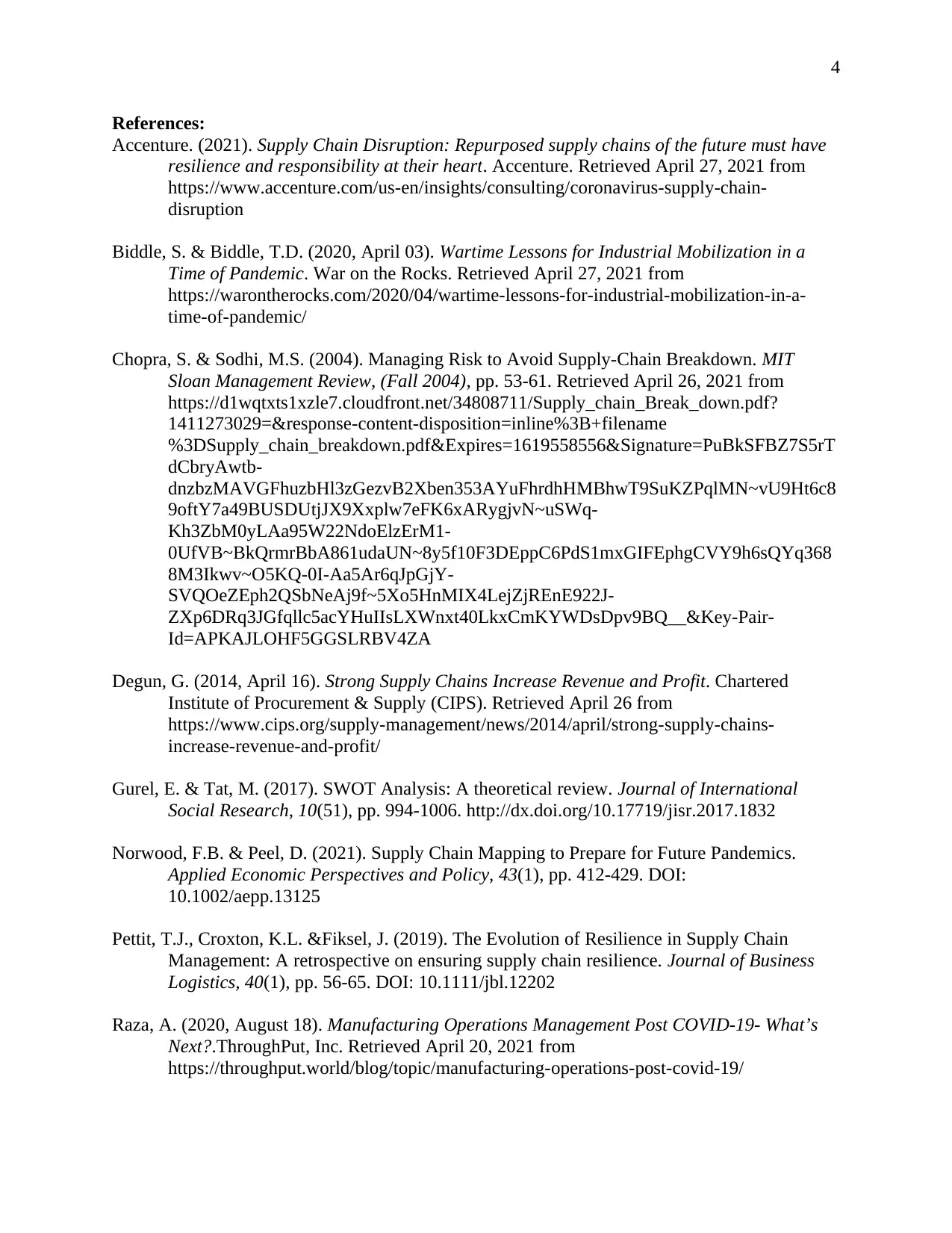
4
References:
Accenture. (2021). Supply Chain Disruption: Repurposed supply chains of the future must have
resilience and responsibility at their heart. Accenture. Retrieved April 27, 2021 from
https://www.accenture.com/us-en/insights/consulting/coronavirus-supply-chain-
disruption
Biddle, S. & Biddle, T.D. (2020, April 03). Wartime Lessons for Industrial Mobilization in a
Time of Pandemic. War on the Rocks. Retrieved April 27, 2021 from
https://warontherocks.com/2020/04/wartime-lessons-for-industrial-mobilization-in-a-
time-of-pandemic/
Chopra, S. & Sodhi, M.S. (2004). Managing Risk to Avoid Supply-Chain Breakdown. MIT
Sloan Management Review, (Fall 2004), pp. 53-61. Retrieved April 26, 2021 from
https://d1wqtxts1xzle7.cloudfront.net/34808711/Supply_chain_Break_down.pdf?
1411273029=&response-content-disposition=inline%3B+filename
%3DSupply_chain_breakdown.pdf&Expires=1619558556&Signature=PuBkSFBZ7S5rT
dCbryAwtb-
dnzbzMAVGFhuzbHl3zGezvB2Xben353AYuFhrdhHMBhwT9SuKZPqlMN~vU9Ht6c8
9oftY7a49BUSDUtjJX9Xxplw7eFK6xARygjvN~uSWq-
Kh3ZbM0yLAa95W22NdoElzErM1-
0UfVB~BkQrmrBbA861udaUN~8y5f10F3DEppC6PdS1mxGIFEphgCVY9h6sQYq368
8M3Ikwv~O5KQ-0I-Aa5Ar6qJpGjY-
SVQOeZEph2QSbNeAj9f~5Xo5HnMIX4LejZjREnE922J-
ZXp6DRq3JGfqllc5acYHuIIsLXWnxt40LkxCmKYWDsDpv9BQ__&Key-Pair-
Id=APKAJLOHF5GGSLRBV4ZA
Degun, G. (2014, April 16). Strong Supply Chains Increase Revenue and Profit. Chartered
Institute of Procurement & Supply (CIPS). Retrieved April 26 from
https://www.cips.org/supply-management/news/2014/april/strong-supply-chains-
increase-revenue-and-profit/
Gurel, E. & Tat, M. (2017). SWOT Analysis: A theoretical review. Journal of International
Social Research, 10(51), pp. 994-1006. http://dx.doi.org/10.17719/jisr.2017.1832
Norwood, F.B. & Peel, D. (2021). Supply Chain Mapping to Prepare for Future Pandemics.
Applied Economic Perspectives and Policy, 43(1), pp. 412-429. DOI:
10.1002/aepp.13125
Pettit, T.J., Croxton, K.L. &Fiksel, J. (2019). The Evolution of Resilience in Supply Chain
Management: A retrospective on ensuring supply chain resilience. Journal of Business
Logistics, 40(1), pp. 56-65. DOI: 10.1111/jbl.12202
Raza, A. (2020, August 18). Manufacturing Operations Management Post COVID-19- What’s
Next?.ThroughPut, Inc. Retrieved April 20, 2021 from
https://throughput.world/blog/topic/manufacturing-operations-post-covid-19/
References:
Accenture. (2021). Supply Chain Disruption: Repurposed supply chains of the future must have
resilience and responsibility at their heart. Accenture. Retrieved April 27, 2021 from
https://www.accenture.com/us-en/insights/consulting/coronavirus-supply-chain-
disruption
Biddle, S. & Biddle, T.D. (2020, April 03). Wartime Lessons for Industrial Mobilization in a
Time of Pandemic. War on the Rocks. Retrieved April 27, 2021 from
https://warontherocks.com/2020/04/wartime-lessons-for-industrial-mobilization-in-a-
time-of-pandemic/
Chopra, S. & Sodhi, M.S. (2004). Managing Risk to Avoid Supply-Chain Breakdown. MIT
Sloan Management Review, (Fall 2004), pp. 53-61. Retrieved April 26, 2021 from
https://d1wqtxts1xzle7.cloudfront.net/34808711/Supply_chain_Break_down.pdf?
1411273029=&response-content-disposition=inline%3B+filename
%3DSupply_chain_breakdown.pdf&Expires=1619558556&Signature=PuBkSFBZ7S5rT
dCbryAwtb-
dnzbzMAVGFhuzbHl3zGezvB2Xben353AYuFhrdhHMBhwT9SuKZPqlMN~vU9Ht6c8
9oftY7a49BUSDUtjJX9Xxplw7eFK6xARygjvN~uSWq-
Kh3ZbM0yLAa95W22NdoElzErM1-
0UfVB~BkQrmrBbA861udaUN~8y5f10F3DEppC6PdS1mxGIFEphgCVY9h6sQYq368
8M3Ikwv~O5KQ-0I-Aa5Ar6qJpGjY-
SVQOeZEph2QSbNeAj9f~5Xo5HnMIX4LejZjREnE922J-
ZXp6DRq3JGfqllc5acYHuIIsLXWnxt40LkxCmKYWDsDpv9BQ__&Key-Pair-
Id=APKAJLOHF5GGSLRBV4ZA
Degun, G. (2014, April 16). Strong Supply Chains Increase Revenue and Profit. Chartered
Institute of Procurement & Supply (CIPS). Retrieved April 26 from
https://www.cips.org/supply-management/news/2014/april/strong-supply-chains-
increase-revenue-and-profit/
Gurel, E. & Tat, M. (2017). SWOT Analysis: A theoretical review. Journal of International
Social Research, 10(51), pp. 994-1006. http://dx.doi.org/10.17719/jisr.2017.1832
Norwood, F.B. & Peel, D. (2021). Supply Chain Mapping to Prepare for Future Pandemics.
Applied Economic Perspectives and Policy, 43(1), pp. 412-429. DOI:
10.1002/aepp.13125
Pettit, T.J., Croxton, K.L. &Fiksel, J. (2019). The Evolution of Resilience in Supply Chain
Management: A retrospective on ensuring supply chain resilience. Journal of Business
Logistics, 40(1), pp. 56-65. DOI: 10.1111/jbl.12202
Raza, A. (2020, August 18). Manufacturing Operations Management Post COVID-19- What’s
Next?.ThroughPut, Inc. Retrieved April 20, 2021 from
https://throughput.world/blog/topic/manufacturing-operations-post-covid-19/
Paraphrase This Document
Need a fresh take? Get an instant paraphrase of this document with our AI Paraphraser
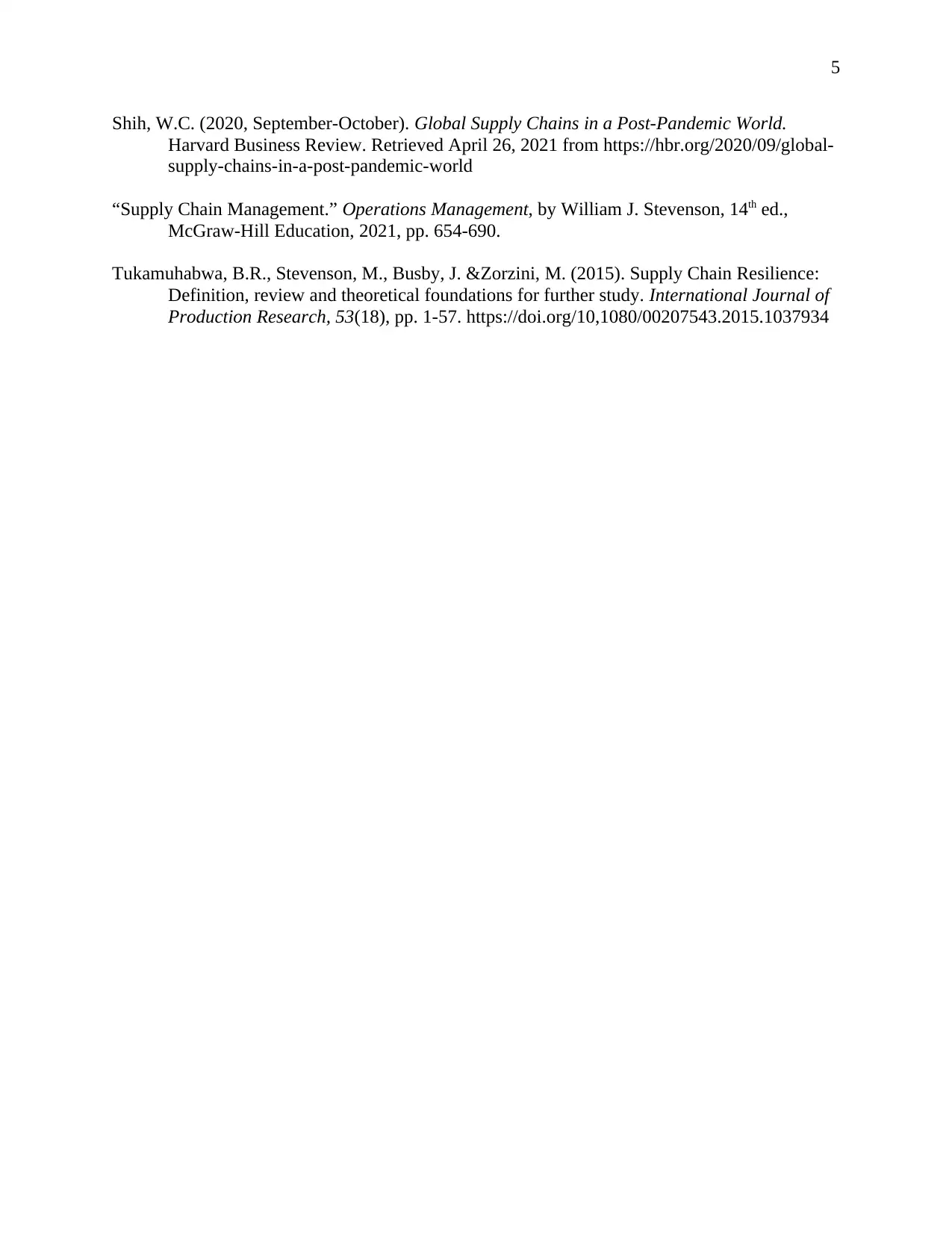
5
Shih, W.C. (2020, September-October). Global Supply Chains in a Post-Pandemic World.
Harvard Business Review. Retrieved April 26, 2021 from https://hbr.org/2020/09/global-
supply-chains-in-a-post-pandemic-world
“Supply Chain Management.” Operations Management, by William J. Stevenson, 14th ed.,
McGraw-Hill Education, 2021, pp. 654-690.
Tukamuhabwa, B.R., Stevenson, M., Busby, J. &Zorzini, M. (2015). Supply Chain Resilience:
Definition, review and theoretical foundations for further study. International Journal of
Production Research, 53(18), pp. 1-57. https://doi.org/10,1080/00207543.2015.1037934
Shih, W.C. (2020, September-October). Global Supply Chains in a Post-Pandemic World.
Harvard Business Review. Retrieved April 26, 2021 from https://hbr.org/2020/09/global-
supply-chains-in-a-post-pandemic-world
“Supply Chain Management.” Operations Management, by William J. Stevenson, 14th ed.,
McGraw-Hill Education, 2021, pp. 654-690.
Tukamuhabwa, B.R., Stevenson, M., Busby, J. &Zorzini, M. (2015). Supply Chain Resilience:
Definition, review and theoretical foundations for further study. International Journal of
Production Research, 53(18), pp. 1-57. https://doi.org/10,1080/00207543.2015.1037934
1 out of 5
Related Documents
Your All-in-One AI-Powered Toolkit for Academic Success.
+13062052269
info@desklib.com
Available 24*7 on WhatsApp / Email
![[object Object]](/_next/static/media/star-bottom.7253800d.svg)
Unlock your academic potential
Copyright © 2020–2025 A2Z Services. All Rights Reserved. Developed and managed by ZUCOL.





